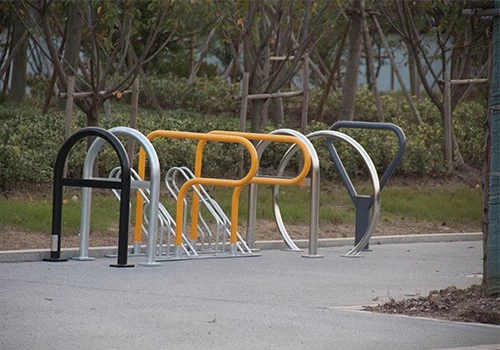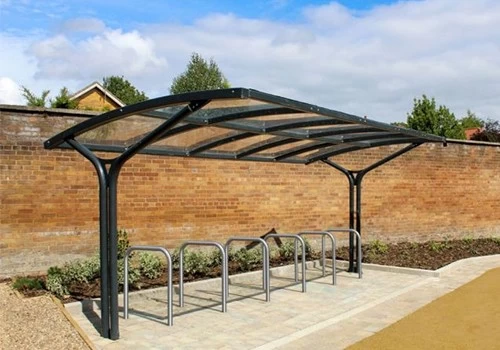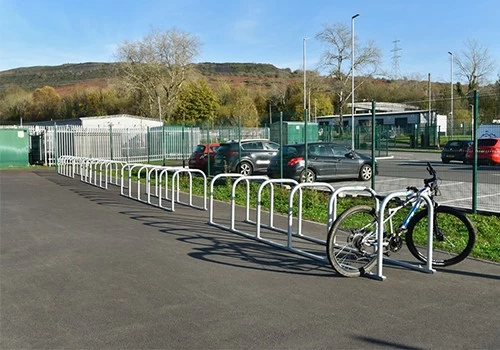Specifications
Model Number : PV-SC-001
Type: Bike parking and storage
Color:Yellow,Black,Green,Red,or Customized.
Style : both indoors and outside
Material : carbon steel
Loading: According to customer need
Size :195*23.2*75cm,200.55*23.2*75cm,or Customized.
Finish: hot-galvanized
Specifications
Model Number : PV-0081-01
Type: Bike parking and storage
Color:silver
Style : both indoors and outside
Material : carbon steel
Loading: According to customer need
Size :Height 1463mm, Depth 1114mm
Finish: hot-galvanized
Model Number : PV-0081-01
Type: Bike parking and storage
Color:Black
Style : both indoors and outside
Material : carbon steel
Loading: 2-10 bikes (According to customer need)
Size :Height 1463mm, Depth 1114mm
Finish: hot-galvanized
Model No.: PV-H1
Size: w605*D400*H330mm
Specification: Round tube:¢16*1.2mm
Finish: Power coated
Net Weight: 1.6 kgs
Packing size:6pcs/ctn
MOQ: 100pcs
Model Number : PV-0024-01
Material : carbon steel/stainless steel
Loading: according customer space size,we can design according the size
Size : W1977*D1130(depend on your parking space)*H2500mm
Finish: Powder coated ,hot-galvanized/electric polish
Packing size :2000*2000*2500mm(40 parking space )
Powder coated ,hot-galvanized/electric polish
Product number:PV-0046-01
Material:carbon steel
Specification:10.2*59*28CM or Customized.
MOQ:100PCS
Port:Shanghai
Trademark:PV
Model Number : PV-0081-01
Type: Outdoor Bike Parking Rack
Style : both indoors and outside
Material : carbon steel
Loading: 2-10 bikes (According to customer need)
Size :170.5*116*148CM
Finish: hot-galvanized
Model Number : PV-0055-01
Type: compact flat pack /slot
Color:black / silver /yellow/optional
Style :Outdoor/indoor
Material : carbon steel/ stainless steel
Capacity : park 6 bikes
Size : L1400*W1054*H840mm
Net weight :38KG
Finish: powder coating / hot galvanized /elctropolishing
Packing size :1490*860*160mm 1pcs/ctn
Product Name: Multi-Capacity Horizontal Two Tier Bike Parking Rack
Material: Carbon Steel
Finish: Powder coated
Post: 80mm * 80mm thickness: 3mm
Steel plate: thickness: 2mm
Dimension: 1325*1890*1830mm
Weight: 370 kg/set
Model: PV-0067-01
Material: stainless steel 304
Pipe: 50 mm* 2.5 mm
Size: 900*700 mm(L*W)
Surface treatment: polishing

The evolution of urban mobility has heightened the importance of cycle racks, with material selection serving as a cornerstone of design efficacy. This comprehensive analysis explores the mechanical, environmental, and economic considerations behind materials ranging from traditional steel and aluminum to cutting-edge composites and stainless steel. By dissecting their properties, manufacturing processes, and real-world applications, this article aims to guide stakeholders—from urban planners to manufacturers—in choosing materials that balance durability, sustainability, and cost-effectiveness. As cities worldwide prioritize cycling as a sustainable transport solution, the right material can transform a simple parking rack into a resilient, aesthetically cohesive element of urban infrastructure.
For decades, steel has dominated the cycle racks industry, a testament to its robust mechanical properties and industrial versatility. As an iron-carbon alloy, steel’s adaptability lies in its compositional flexibility: carbon steel, the most basic form, spans a spectrum from low-carbon grades (ideal for malleable, cost-effective structures) to high-carbon variants prized for industrial-grade strength. Low-carbon steel, with its inherent ductility and ease of welding, finds common use in community parking solutions—think modest bike racks in suburban neighborhoods or campus bike corrals, where simplicity and affordability take precedence over extreme load-bearing capacity. Medium-carbon steel, often heat-treated to enhance hardness, strikes a balance between strength and workability, making it the go-to for urban street racks that must withstand daily use by commuters and casual riders alike.
Carbon steel cycle racks, though less common in standard parking applications, plays a critical role in specialized contexts. Industrial warehouses or heavy-duty transit hubs, for example, may employ high-carbon steel racks to secure cargo bikes or fleets of utility bicycles, where the material’s exceptional tensile strength outweighs its brittleness and welding challenges.
Beyond carbon steel, low-alloy steel emerges as a hybrid solution, blending the familiarity of traditional steel with enhanced performance via minor alloy additions. Elements like manganese boost tensile strength, while chromium and nickel impart corrosion resistance, making low-alloy steel a strategic choice for coastal cities or industrial zones plagued by air pollution. Here, the material’s ability to withstand salt-laden air or acidic rain without compromising structural integrity ensures a longer lifespan, even in environments that would degrade untreated carbon steel within years.
The manufacturing journey of steel cycle racks is as diverse as the material itself. Rolling mills shape raw steel into standardized profiles—round bars, angle irons, and channel steel—each tailored to specific load requirements. Welding, a make-or-break step, demands precision: gas metal arc welding (GMAW) is often favored for its speed and consistency in mass production, while stick welding may be used for on-site repairs or custom fabrications. Surface treatments are the final line of defense against corrosion: hot-dip galvanizing, which coats steel in a protective zinc layer, remains the gold standard for outdoor racks, offering up to 50 years of rust resistance in optimal conditions. Powder coating, meanwhile, adds a layer of aesthetic versatility, allowing cities to color-code racks for wayfinding or align with local branding initiatives.
Yet, steel’s dominance is not without trade-offs. Its density—a virtue in load-bearing scenarios—becomes a liability in logistics: installing a single steel rack can require multiple workers, and retrofitting urban areas with prefabricated steel structures often involves heavy machinery. Additionally, while surface treatments delay corrosion, they do not eliminate it. In tropical climates or near industrial sites, even galvanized steel may succumb to rust over time, necessitating periodic inspections and repainting—a hidden cost that can erode the material’s initial affordability over decades of use.

As urban planners increasingly prioritize ease of installation and low maintenance, aluminum has emerged as a compelling alternative to steel. The secret lies in its alloy composition: by integrating elements like magnesium, silicon, or zinc, manufacturers unlock a range of properties that cater to diverse needs. The 6061-T6 alloy, a staple in the industry, exemplifies this versatility. With a balance of medium strength, excellent weldability, and natural resistance to oxidation, it’s the material of choice for sleek, modern racks in downtown districts, where aesthetics matter as much as functionality. Its lightweight nature—aluminum is roughly one-third the density of steel—revolutionizes installation: a team of two can easily maneuver and secure an aluminum rack, reducing labor costs and minimizing street closures during setup.
Aluminum’s corrosion resistance is perhaps its greatest asset. Unlike steel, which requires artificial coatings to stave off rust, aluminum forms a thin oxide layer upon exposure to air, creating a self-healing barrier against moisture and chemicals. This makes it ideal for high-humidity environments, such as cities along major waterways or tropical regions, where steel racks would demand frequent upkeep. Anodizing, a electrolytic process that thickens this oxide layer, further enhances durability while allowing for vibrant, fade-resistant colors—from matte blacks to bold blues, perfect for urban art installations or bike-sharing hubs that double as visual landmarks.
However, aluminum’s strengths are matched by distinct limitations. Its lower tensile strength compared to steel restricts its use in high-load scenarios; a heavy-duty cargo bike rack, for instance, would require a steel frame to prevent sagging or deformation. Additionally, while aluminum is highly recyclable, the energy-intensive smelting process behind virgin aluminum raises environmental concerns. Manufacturers are addressing this by increasing the use of recycled content, but the material still carries a higher carbon footprint than reclaimed steel in some cases. Cost-wise, aluminum alloys often come at a premium compared to carbon steel, though this is offset by reduced maintenance costs over the rack’s lifetime.

Innovations in materials science have introduced composites to the cycle racks landscape, offering solutions that defy the limitations of traditional metals. Fiberglass-reinforced polymer (FRP) composites, for example, combine the rigidity of glass fibers with the moldability of polymer resins, resulting in structures that are both featherlight and incredibly strong. This makes them ideal for coastal cities or industrial zones where salt, chemicals, and moisture pose constant threats to metal racks. Unlike steel or aluminum, FRP is non-conductive, a critical advantage in areas with underground electrical infrastructure or frequent lightning strikes.
Carbon fiber composites, though pricier, take performance to another level. Used in high-end applications—such as premium bike-sharing systems in tech-forward cities—they offer a strength-to-weight ratio unmatched by metals, enabling the creation of sculptural, minimalist racks that appear almost weightless. Their resistance to UV degradation and impact makes them suitable for high-traffic areas, where vandalism or accidental collisions are common.
Yet, composites are not without challenges. Their production involves complex layup processes and curing under high heat and pressure, driving up manufacturing costs. Recycling remains a hurdle: while metals can be melted down and reused, composite materials are often difficult to disassemble, leading to environmental waste if not properly managed. Additionally, their brittleness under sustained heavy loads limits their use in industrial or commercial settings where racks must accommodate dozens of bikes at once.
For projects where durability and aesthetics reign supreme, stainless steel cycle racks alone. Grades like 304 and 316 are defined by their chromium and nickel content, which give them an almost impervious resistance to corrosion. 304 stainless steel, the most common grade, thrives in urban environments with moderate pollution, offering a polished finish that requires little more than an occasional wipe-down to maintain its luster. In marine environments or near chemical plants, 316 stainless steel—with its added molybdenum—becomes indispensable, shrugging off even the harshest salt spray or acidic runoff.
The allure of stainless steel lies in its timeless appeal. Its sleek, modern appearance makes it a favorite in upscale neighborhoods, transit hubs, or architectural projects where the parking rack must blend seamlessly with high-design surroundings. However, this premium comes at a cost: stainless steel is significantly more expensive than carbon steel or aluminum, and its fabrication requires specialized equipment and skilled welders to avoid heat-induced discoloration or structural weaknesses. Its weight, while less than steel, is still higher than aluminum, making it less ideal for temporary or mobile installations.
Selecting the right material for a cycle racks hinges on a trifecta of factors: functional requirements, environmental context, and budget. For a large-scale municipal project in a rainy coastal city, aluminum or FRP composites might be the logical choice, balancing corrosion resistance with installation ease. A university campus on a tight budget, meanwhile, might opt for galvanized carbon steel cycle racks, prioritizing upfront cost savings over long-term maintenance. In luxury developments or landmark sites, stainless steel offers a “fit-and-forget” solution, justifying its higher price tag with decades of trouble-free service.
Sustainability is also emerging as a key consideration. Many cities now mandate recycled content in public infrastructure, pushing manufacturers to incorporate reclaimed steel or post-consumer aluminum into their designs. Composite manufacturers, too, are experimenting with bio-based resins derived from plant materials, reducing reliance on fossil fuels. As circular economy principles gain traction, the recyclability of steel and aluminum—combined with advances in composite recycling—will likely shape future material trends.
The world of cycle racks materials is a dynamic ecosystem, where each option—from humble carbon steel to cutting-edge composites—serves a unique purpose. Steel remains the workhorse, reliable and cost-effective for straightforward applications. Aluminum and composites challenge its dominance in environments where weight, corrosion, or design innovation are paramount. Stainless steel, meanwhile, elevates parking infrastructure to a level of sophistication suited to premium contexts.
As cities evolve, so too will their material needs. The next generation of parking racks may well blend the best of all worlds: steel frameworks for structural integrity, aluminum cladding for lightness and color, and composite components for specialized resistance. Above all, the goal remains clear: to create infrastructure that is not just functional, but future-proof—ready to meet the demands of a cycling-friendly, sustainably built world. By embracing this diversity of materials, urban planners and designers can ensure that every bicycle parking rack is not just a place to lock a bike, but a testament to the ingenuity and resilience of modern cities.